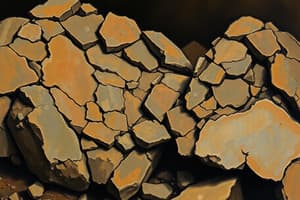Podcast
Questions and Answers
What are intrusive volcanic features formed by?
What are intrusive volcanic features formed by?
Molten rock that cools and hardens before it reaches the earth’s surface.
Which of the following describes a sill?
Which of the following describes a sill?
- A large intrusive feature formed underground.
- A horizontal sheet of rock formed between two rock layers. (correct)
- A vertical pipe of rock formed from molten material.
- A vertical sheet of igneous rock that resists erosion.
What is a dyke?
What is a dyke?
A vertical sheet of igneous rock formed by magma moving directly upward.
Where is a batholith notably found?
Where is a batholith notably found?
What is a plug in volcanic terms?
What is a plug in volcanic terms?
Flashcards are hidden until you start studying
Study Notes
Geography of Kuvika
- Intrusive volcanic features form from molten rock that cools and solidifies before reaching the surface.
- Magma typically occurs along weaknesses in the earth's crust, creating narrow joints that widen from a few centimeters to tens of meters.
- Additional magma flows into the joint, exerting pressure on the molten rock beneath, leading to the formation of sheets of rock that intersperse with surrounding material.
Examples of Intrusive Volcanic Features
-
Sill:
- Formed between two rock layers as magma flows horizontally, parallel to the earth's surface.
-
Dyke:
- A vertical sheet of igneous rock created by magma ascending directly to resist erosion.
- Notable dykes can be found at the southern tip of a headland in Saint Lucia.
-
Batholith:
- A large intrusive feature resulting from the cooling and solidification of a substantial underground reservoir of molten rock.
- An example exists in the central part of Tobago.
-
Plug:
- A vertical rock pipe formed from molten material in a volcano's vent that cools and hardens.
- Can become exposed as a steep-sided rock when surrounding volcanic structures erode.
Studying That Suits You
Use AI to generate personalized quizzes and flashcards to suit your learning preferences.




